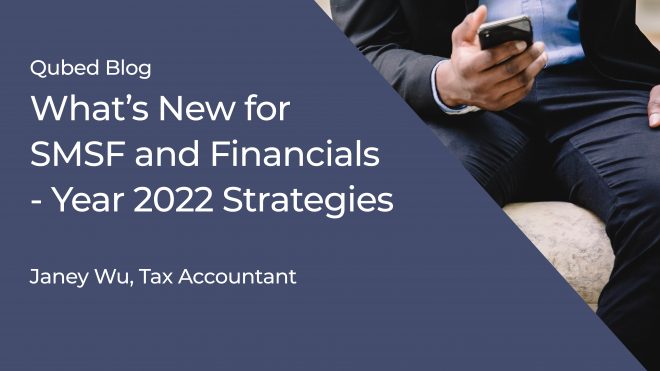As part of the 2021/2022 Federal Budget, the Australian Government announced several changes for SMSFs and have provided more flexibility for individuals to make contributions to their superannuation fund.
Making the most of 2022 – what you need to know
Removing the ‘work test’ for certain voluntary superannuation contributions
The Government announced in 2021/2022 Budget that they proposed to remove the work test requirements from 1 July 2022 for individuals aged 67 to 74 years who make or receive non-concessional contributions or salary sacrificed contributions subject to contribution caps. Individuals who make contributions to claim a deduction are still required to meet the work test requirements. This measure will provide more flexibility for older Australians to boost their retirement savings.
Reducing the age requirement for making downsizer contributions
The Government announced in 2021/2022 Budget that they proposed to reduce the age eligibility for individuals from 65 to 60 who make downsizer contributions.
The downsizer contribution allows individuals to make after-tax contributions up to $300,000 per person or $600,000 per couple from the sale of their main residence that held for at least 10 years. The downsizer contribution was introduced from 1 July 2018 and provided benefits for older Australians who intend to downsize their home move to more suitable accommodation from using the sale proceeds to increase their retirement savings. Moreover, downsizer contributions are not subject to the work test and the non-concessional contribution caps.
Relaxing the residency requirements for SMSFs
In the 2021/2022 Budget, the Government announced that it will relax the residency requirements for SMSFs by extending the central control and management test safe harbour from two years to five years and remove the active member test.
Under the current legislation, SMSFs are required to meet all the three residency tests. Without meeting the residency test requirements, SMSFs are taxed at the highest marginal rate which is currently 45%. The proposed changes provide more flexibility for SMSF members to continue to contribute to their superannuation fund whilst temporarily overseas without breach the residency test.
Proposed changes affecting the First Home Super Saver (‘FHSS’) scheme
As part of 2021/2022 Budget, the Government announced that the release amount under the scheme will increased from $30,000 to $50,000 to assist first home buyers to purchase their home.
The Government also announced that it will improve the operation of the First Home Super Saver Scheme (FHSSS) scheme and provide greater flexibility for the application process by:
- increasing the discretion of the Commissioner of Taxation to amend and revoke FHSSS applications
- allowing individuals to withdraw or amend their applications prior to them receiving a FHSSS amount, and allowing those who withdraw to re-apply for FHSSS releases in the future
- allowing the Commissioner to return the released FHSSS money to super funds, provided that the money has not yet been released to the individual
- clarifying that the money returned to super funds is treated as funds’ non-assessable non-exempt income and does not count towards the individual’s contribution caps.
In addition, there are number of latest developments that affect the super contribution rules.
Increase of concessional contribution cap, non-concessional contribution cap and total super balance from 1 July 2021
From 1 July 2021, the concessional contribution cap increased from $25,000 to $27,500, and the non-concessional contribution cap increased to $110,000 (previously $100,000) or up to $330,000 (previously $300,000) under the bring-forward rule. The total super balance requirement to make non-concessional contributions has increased to $1,700,000 from $1,600,000.
A higher concessional contribution cap could apply under the ‘catch-up’ concession for unused concessional contributions amounts. An individual’s standard concessional contribution cap of $27,500 from 1 July 2021 can potentially be further increased under the ‘catch-up’ concession for concessional contribution, which allows eligible individuals to carry forward up to five years’ worth of unused concessional contribution cap to be utilised in a later income year.
Removal of excess concessional contribution charge for excess concessional contributions
From 1 July 2021, an individual will no longer be liable to pay the excess concessional contribution charge for contributions that exceed their concessional contribution cap. This will have the effect of softening the impact of breaching the concessional contribution cap for an individual.
All other tax consequences of breaching the concessional contribution cap will remain the same. The ATO is still required to issue the individual with an excess concessional contributions determination to state the amount of excess concessional contributions for the year, which will be taxable to the individual at their marginal tax rates with the benefit of a 15% tax offset. The option of electing to have up to 85% of excess concessional contributions released from a fund will also continue to be available to an individual with excess concessional contributions.
What do the changes mean to you? What are the strategies to maximise super contributions and to achieve your retirement goals? Contact Qubed Advisory for further information.
Janey Wu, Tax Accountant



